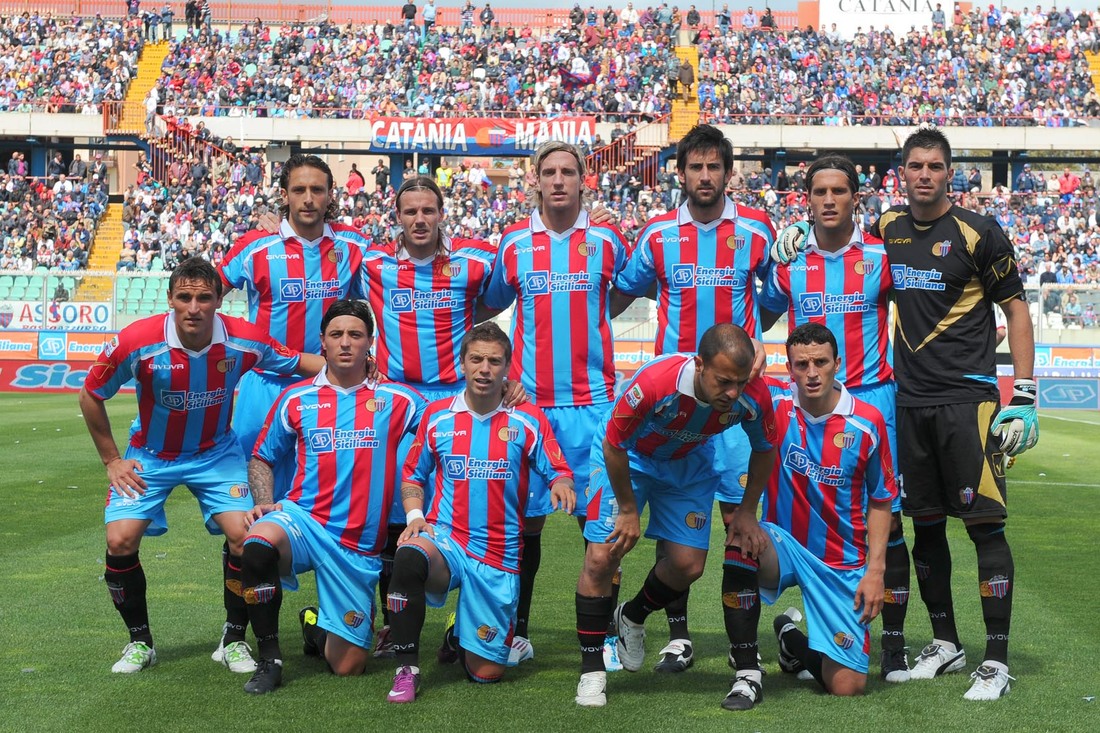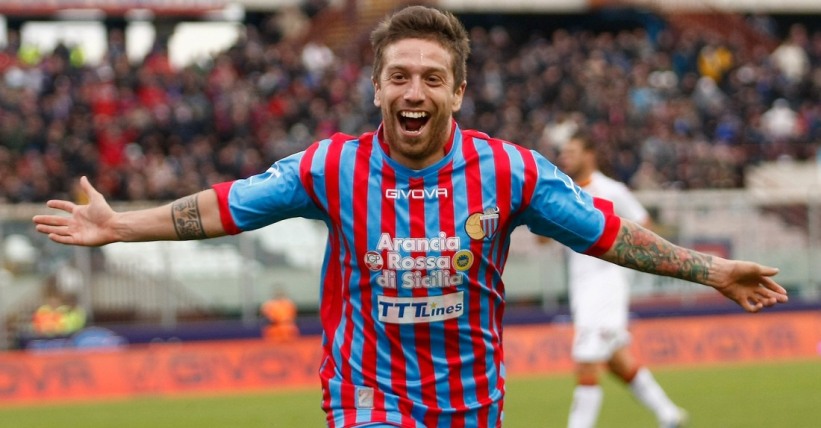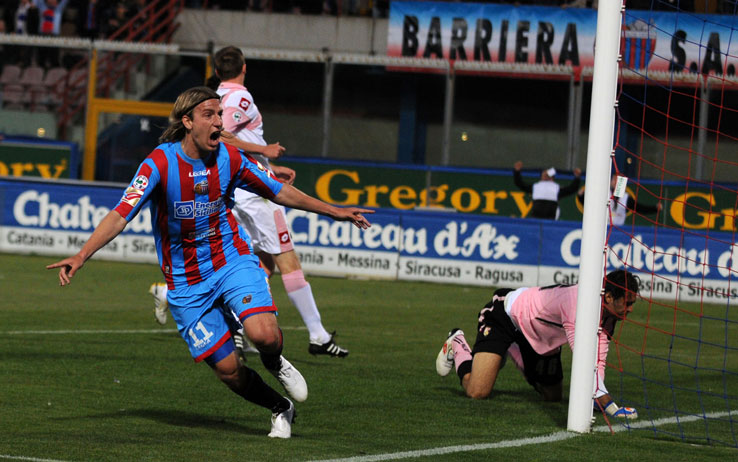With the inevitable exception of Palermo supporters, every devotee of Italian football cannot help but sigh when looking at the current state of affairs in Catania. The recent history of the club, that is to say since their relegation to Serie B in 2014, is characterised by disappointing results, match-fixing scandals and the gradual evaporation of one of Serie A’s most exciting underdogs. Memories are all that is left of those thrilling games at the Stadio Massimino Cibali. Thus, with a melancholic note, let us remember everyone’s favourite Catania side: the record-breaking troop of Argentinos that took the 2010-11 season by storm.
Operating in the background, yet perhaps playing the most important role, was the real architect of that brilliant team: CEO Pietro Lo Monaco. A keen observer of Argentinian futbol – a very appealing low-cost, but talent-rich market – Lo Monaco gradually constructed a real Argentine colony under the flashes of Mount Etna. In fact, by the beginning of the 2010 campaign, Catania had become the most South-American team in Europe, counting as many as 12 Argentinians in their ranks. The fruits of Lo Monaco’s Football Manager-like team building were picked during that very same season, when the club broke their record Serie A points tally: finishing with 46.
In reality, the record was already broken with the achievement of 45 points, reached in the most breathtaking fashion with a 2-1 home victory over Roma. The protagonists of that unexpected landmark were two members of the Argentinian funky bunch: Gonzalo Bergessio and Alejandro ‘El Papu’ Gomez, the first with a poacher’s header, and the second with a burst into the box and a tidy finish.
But this was not just a one off, especially for Gomez. Throughout the season, the diminutive Argentine demonstrated the qualities that have since helped establish him as one of the best wingers currently playing in Italy. Arriving from San Lorenzo in the summer of 2010, El Papu suffered no problems in adapting: his verve, dribbling and acceleration made him Catania’s star player. Bergessio’s acclimatisation was just as smooth. Arriving in Catania during the January window, to substitute the departing Pablo Barrientos (another Argentinian), Bergessio bagged five goals for the club, three of which proved decisive in securing 2-1 wins.
Papu Gomez celebrates in his former colours of Rossazzurri
In addition to Bergessio, the January transfer window saw the arrival of another Argentinian hero for the Elefanti: none other than Diego Pablo Simeone, in the role of head-coach, of course. Inspiring his team from the sidelines, Simeone galvanised the typical Argentine qualities of the band of 12 at his disposal. El Cholo’s Catania combined a mixture of ferociousness and creativity, typical of Argentinian culture: garra y magia; ‘grit and magic’.
This grit was embodied by the Rossazzurri’s central defenders, comprising of Nicolas Spolli and Matias Silvestre: the former a sturdy and no-nonsense defender, the latter a technical operator and a goal-scorer (Silvestre scored six that year). Behind them was Mariano Andùjar, a solid goalkeeper who was even called up to the Argentine Selecciòn 11 times – a luxury for a club like Catania. Adding dynamism and fantasy in midfield was Serie B icon Adrian Ricchiuti, but commitment and tenacity were also important components in this department, and these qualities were provided by Ezequiel Carboni, Pablo Ledesma and Mariano Izco.
In fact, Izco, who later became club-captain, was the first of these Argentinians to play at Catania, arriving as early as 2006. Joining up with the team during their Austrian summer tour, Izco memorably expressed his concern at not speaking either German or Italian, and consequently feeling lost. Little did Izco know that in the next four years, there would be more Argentines than Italians in the team, and it would be these Italians who had to adapt and learn Spanish instead.
Amidst this well-balanced core of players, and together with the aforementioned starlet Gomez, the team enjoyed the presence of a real leader; a former Barça player with international experience and a respectable goal-scoring record. In fact, many forget that Maxi Lopez once played for the Catalans, who spent €6.5 million to secure his signature in 2005. It is often forgotten because Lopez’s career failed to meet the expectations that naturally face any Barcelona signing. But in 2011, the Catanesi cared little for Lopez’s substandard past. La Galina de Oro, the ‘Golden Chicken’, joined Catania in January, scoring an impressive 11 goals in 17 matches for the club. Physically strong and a clinical finisher, he was a season-changer for the team and their driving force in attack.
Maxi Lopez scores in the Derby di Sicilia against Palermo in 2010
But like any adequate underdog story, the ending always reserves a place for a sense of bitterness. After two more great seasons, including a historic 8th place finish in 2013, the group slowly started to be broken up and the club began their descent. El Papu gave in to the lure of Metalist’s Ukrainian money, as well as their access to European football. Maxi attempted the breakthrough into the higher tier of Italian football with AC Milan and Sampdoria – two unsuccessful stints. The most nostalgic members of the crew, like Ledesma and Carboni, decided to go back to their motherland. Silvestre left for eternal rivals Palermo, which was not overly appreciated on the red and blue side of the Island.
Sadly, by 2013, the famous Selecciòn Catania that had conquered the hearts of every Calcio aficionado was no more. The Stadio Cibali’s vibrant colours and atmosphere with Etna glowing in the background, Catania’s mesmerising Tiki-Taka, Simeone roaring from the sidelines; it had all been disbanded.
Brazilian lyricist and novelist Paulo Coelho once said, “What matters is to leave in the past those moments in life that are over.” Let us disagree with Coelho; let us allow that Argentine colony, that spark of footballing brilliance, to remain vivid in our memories, to keep breaking records, to not let that dream be over. Hasta siempre, Selecciòn Catanaia
Words by Federico Manasse: @FedericoManasse
Federico is a columnist, editor and sketch artist for Italian Football Daily. He also writes for the Football Pink and his own website, Fede’s Calcio.



